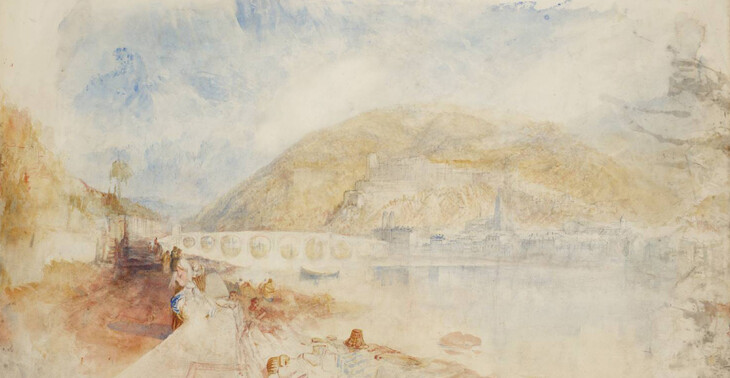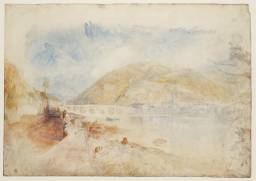From the entry
This section comprises a single sheet, with a large colour study of Heidelberg and its castle across the River Neckar developed to quite an advanced stage. With variations, it relates in particular to two large, finished watercolours of the early 1840s: the afternoon scene known as Heidelberg with a Rainbow (private collection) and another, Heidelberg, Sunset, with the moon rising (Manchester Art Gallery). The first of these was the source for Heidelberg from the Opposite Bank of the Neckar, a large steel engraving by Thomas Abiel Prior, published in 1846 (Tate impression: T05190); the work addressed here may represent an intermediate stage between Prior’s own reported sketch of the scene and the full-fledged interpretation he commissioned from Turner. A third finished variation is Heidelberg (National Galleries Scotland, Edinburgh), which is usually dated to around 1846. As reflected in the holdings of many finished watercolour designs and colour studies in the Turner Bequest, ever since 1794 ...
D36325
Turner Bequest CCCLXV 34
Turner Bequest CCCLXV 34
This section comprises a single sheet, with a large colour study of Heidelberg and its castle across the River Neckar developed to quite an advanced stage. With variations, it relates in particular to two large, finished watercolours of the early 1840s: the afternoon scene known as Heidelberg with a Rainbow (private collection)1 and another, Heidelberg, Sunset, with the moon rising (Manchester Art Gallery).2 The first of these was the source for Heidelberg from the Opposite Bank of the Neckar, a large steel engraving by Thomas Abiel Prior, published in 1846 (Tate impression: T05190); the work addressed here may represent an intermediate stage between Prior’s own reported sketch of the scene and the full-fledged interpretation he commissioned from Turner. A third finished variation is Heidelberg (National Galleries Scotland, Edinburgh),3 which is usually dated to around 1846.
As reflected in the holdings of many finished watercolour designs and colour studies in the Turner Bequest, ever since 1794 Turner had been increasingly intensively involved with the print market, largely through commissions to make highly finished watercolours of topographical subjects to be engraved as separate plates, in series or as illustrations, which he supervised very closely.4 During the 1830s, a busy decade resulting in many steel engravings for books, publication of the last and most ambitious of the series of traditional copper engravings from Turner’s designs, the Picturesque Views in England and Wales, had petered out in 1838 as the demand for such productions declined. A few large single plates engraved on copper continued to be issued through the 1840s, along with more durable steel engravings like Prior’s, although these were largely after Turner’s oil paintings.
Andrew Wilton, J.M.W. Turner: His Life and Work, Fribourg 1979, p.465 no.1377, as ‘Heidelberg, with a rainbow’, c.1841, pl.245.
How to cite
Matthew Imms, ‘Colour Study Relating to ‘Heidelberg from the Opposite Bank of the Neckar’ c.1841’, April 2024, in David Blayney Brown (ed.), J.M.W. Turner: Sketchbooks, Drawings and Watercolours, Tate Research Publication, November 2024, https://www


